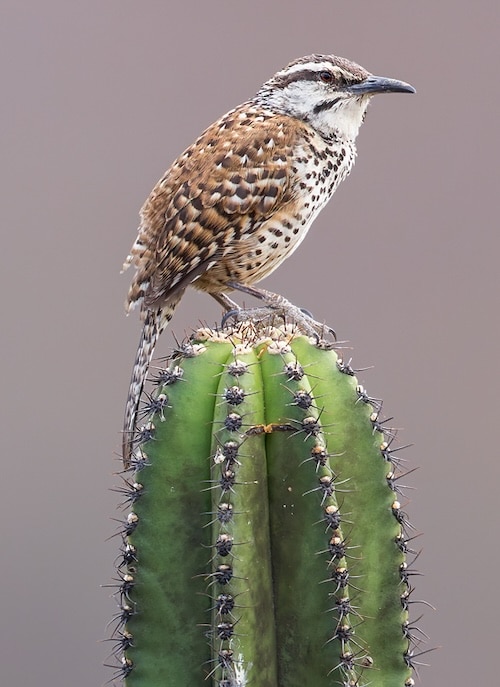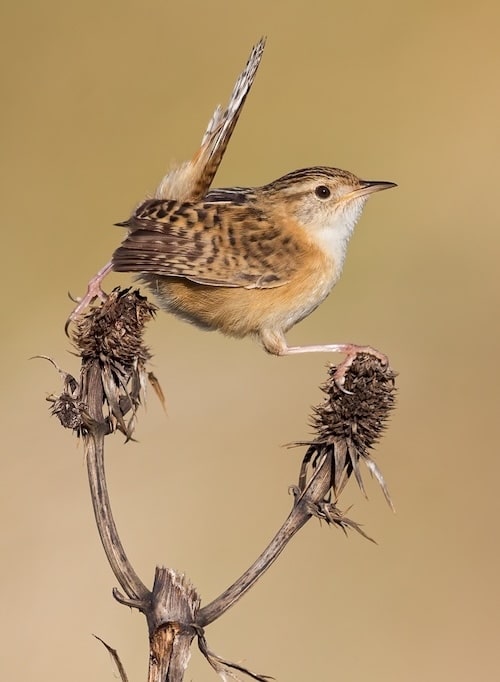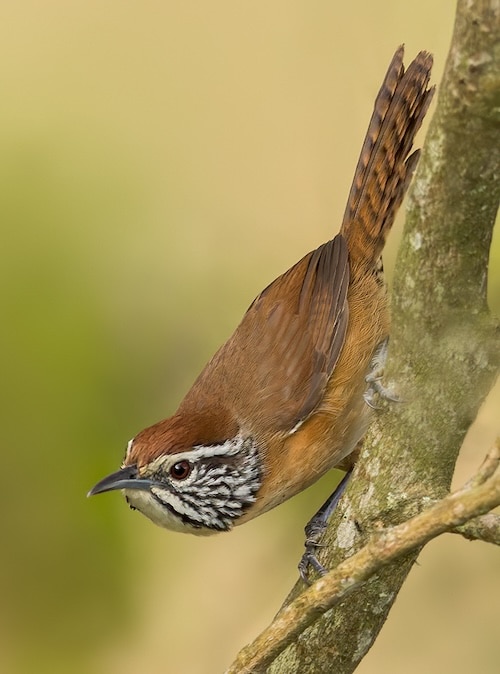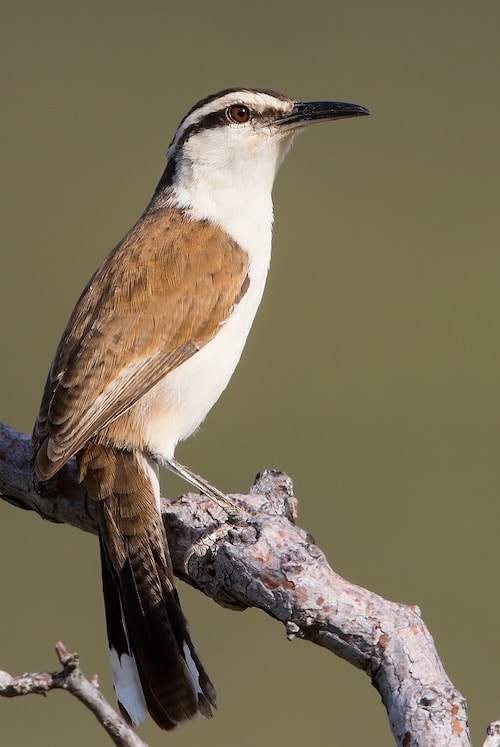Troglodytidae – Wrens
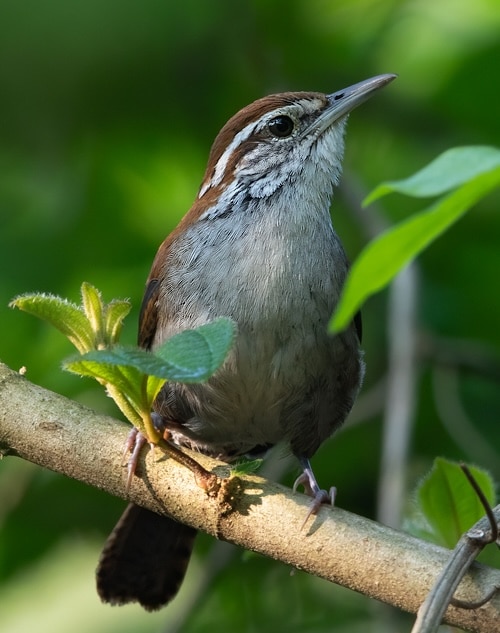
The Troglodytidae are mostly small, brownish passerine birds in the mainly New World family commonly known as wrens. 88 species of true wrens in roughly 20 genera are described. Only the Eurasian Wren occurs in the Old World, where in Anglophone regions, it is commonly known simply as the ‘wren’, as it is the originator of the name. The name wren has been applied to other, unrelated birds, particularly the New Zealand wrens Acanthisittidae and the Australian wrens Maluridae.
Most wrens are small and rather inconspicuous, except for their loud and often complex songs. Notable exceptions are the relatively large members of the genus Campylorhynchus, which can be quite bold in their behaviour. Wrens have short wings that are barred in most species, and they often hold their tails upright. As far as known, wrens are primarily insectivorous, eating insects, spiders, and other small arthropods, but many species also eat vegetable matter and some take small amphibians and reptiles.
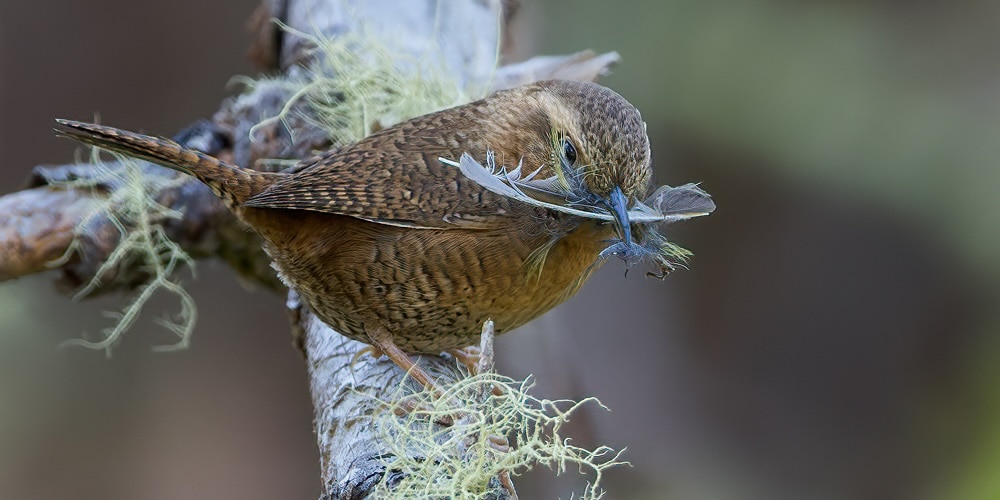
House Wren Troglodytes aedon
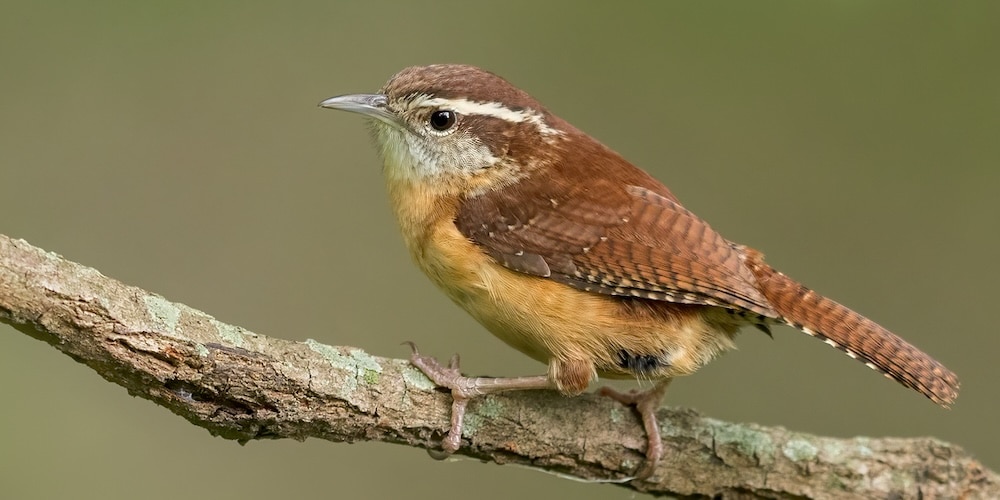
Carolina Wren Thryothorus ludovicianus
The Eurasian Wren is among the smallest birds in its range, while the smaller species from the Americas are among the smallest passerines in that part of the world. They range in size from the White-bellied Wren, which averages under 10cm and 9g, to the Giant Wren, which averages about 22cm and weighs almost 50g . The dominating colours of their plumage are generally drab, composed of grey, brown, black, and white, and most species show some barring, especially to tail and/or wings. No sexual dimorphism is seen in the plumage of wrens, and little difference exists between young birds and adults. They have loud and often complex songs, sometimes given in duet by a pair. The song of members of the genera Cyphorhinus and Microcerculus have been considered especially pleasant to the ear.
|
|
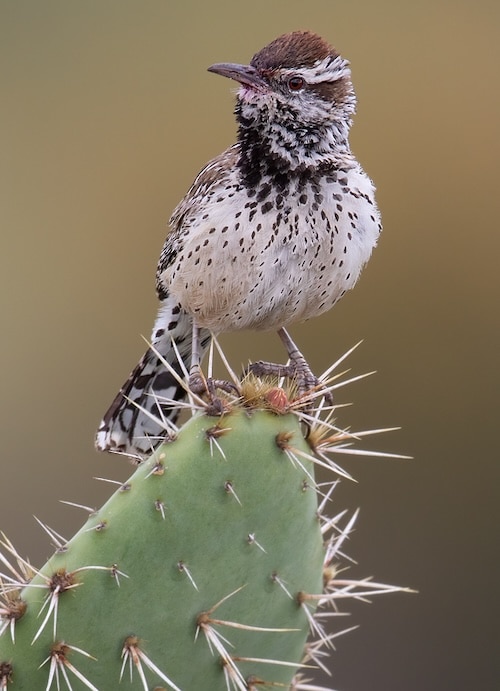
|
|
Boucard’s Wren Campylorhynchus jocosus |
Cactus Wren Campylorhynchus brunneicapillus |
|
|
|
| Grass Wren Cistothorus platensis |
Happy Wren Pheugopedius felix |
|
All photographs on this page courtesy of ©Dubi Shapiro |
|
Wrens are principally a New World family, distributed from Alaska and Canada to southern Argentina, with the greatest species richness in the Neotropics. As suggested by its name, the Eurasian Wren is the only species of wren found outside the Americas, as restricted to Europe, Asia, and northern Africa (it was formerly considered conspecific with the Winter Wren and Pacific Wren of North America). The insular species include the Clarión Wren and Socorro Wren from the Revillagigedo Islands in the Pacific Ocean, and Cobb’s Wren in the Falkland Islands, but few Caribbean islands have a species of wren, with only the Southern House Wren in the Lesser Antilles, the Cozumel Wren of Cozumel Island, and the highly restricted Zapata Wren in a single swamp in Cuba.
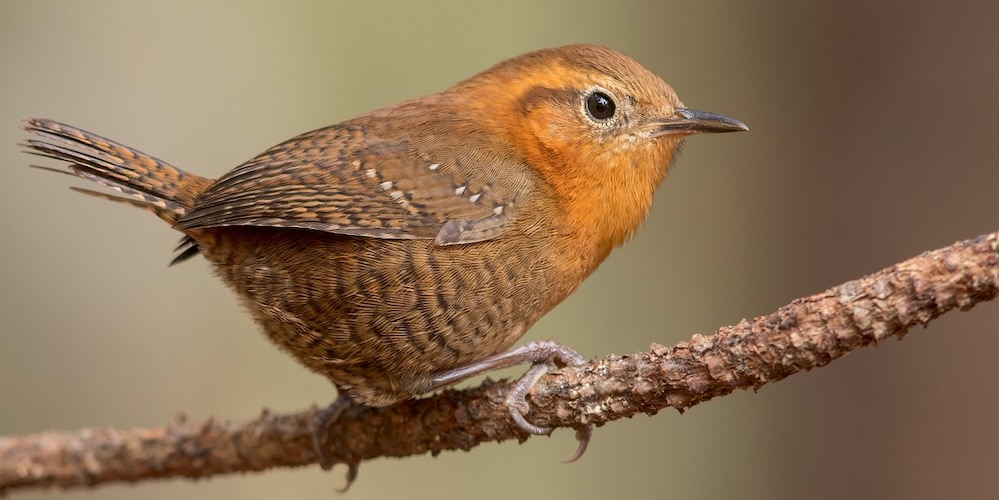
Rufous-browed Wren Troglodytes rufociliatus
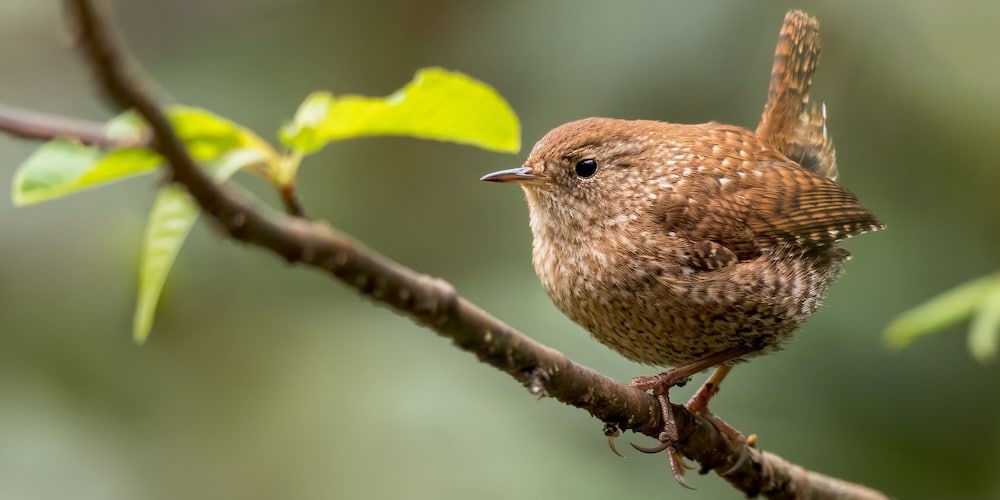
Winter Wren Troglodytes hiemalis
The various species occur in a wide range of habitats, ranging from dry, sparsely wooded country to rainforest. Most species are mainly found at low levels, but members of the genus Campylorhynchus are frequently found higher, and the two members of Odontorchilus are restricted to the forest canopy.
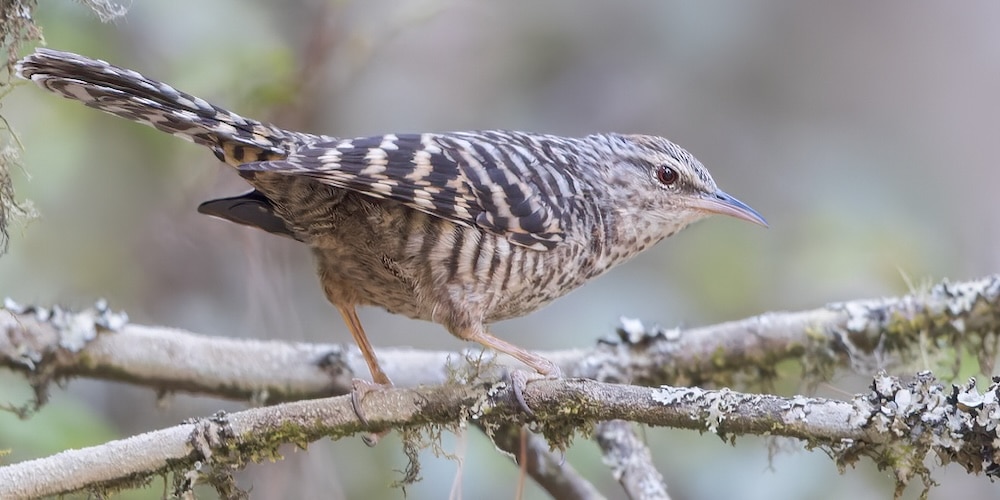
Grey-barred Wren Campylorhynchus megalopterus
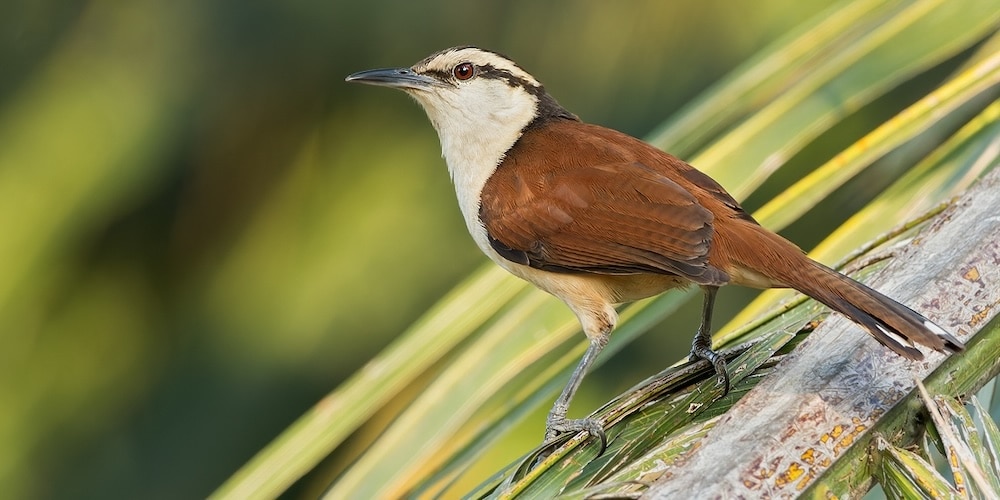
Giant Wren Campylorhynchus chiapensis
A few species, notably the Eurasian Wren and the House Wren, are often associated with humans. Most species are resident, remaining in Central and South America all year round, but the few species found in temperate regions of the Northern Hemisphere are partially migratory, spending the winter further south.
Wrens vary from highly secretive species such as those found in the genus Microcerculus to the highly conspicuous genus Campylorhynchus, the members of which frequently sing from exposed perches. The family as a whole, exhibits a great deal of variation in their behaviour. Temperate species generally occur in pairs, but some tropical species may occur in parties of up to 20 birds.
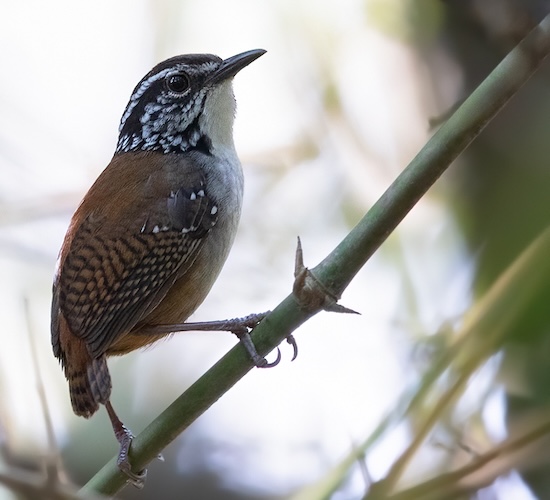
White-breasted Wood Wren Henicorhina leucosticta
Wrens build dome-shaped nests, and may be either monogamous or polygamous, depending on species.
Though little is known about the feeding habits of many of the Neotropical species, wrens are considered primarily insectivorous, although many species also take vegetable matter such as seeds and berries; the Eurasian Wren has been recorded wading into shallow water to catch small fish and tadpoles; Sumichrast’s Wren and the Zapata Wren take snails; and the Giant Wren and Marsh Wren have been recorded attacking and eating bird eggs (in the latter species, even eggs of conspecifics). A local Spanish name for the Giant Wren and Bicolored Wren is ‘chupahuevo’ (egg-sucker), but whether the latter actually eats eggs is unclear.
|
|
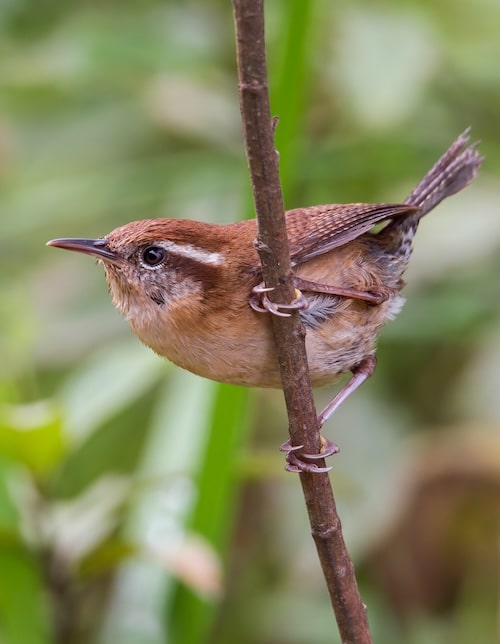
|
| Black-bellied Wren Pheugopedius fasciatoventris | Mountain Wren Troglodytes solstitialis |
|
|
|
| Bicolored Wren Campylorhynchus griseus |
Sclater’s Wren Campylorhynchus humilis |
The Plain Wren and Northern Wren sometimes destroy eggs and the Rufous-and-white Wren has been recorded killing nestlings, but this is apparently to eliminate potential food competitors rather than feed on the eggs or nestlings. Several species of Neotropical wrens sometimes participate in mixed-species flocks or follow army ants, and the Eurasian Wren may follow badgers to catch prey items disturbed by them.
-
Number of bird species: 95
(As at November 2025)
According to the recently (2025) amalgamated AviList, there are ninety-five species, in nineteen genera in the Troglodytidae family. They are:
Rock Wren Salpinctes obsoletus
Canyon Wren Catherpes mexicanus
Sumichrast’s Wren Hylorchilus sumichrasti
Nava’s Wren Hylorchilus navai
Northern Nightingale-Wren Microcerculus philomela
Southern Nightingale-Wren Microcerculus marginatus
Flutist Wren Microcerculus ustulatus
Wing-banded Wren Microcerculus bambla
Carolina Wren Thryothorus ludovicianus
Bewick’s Wren Thryomanes bewickii
White-headed Wren Campylorhynchus albobrunneus
Band-backed Wren Campylorhynchus zonatus
Grey-barred Wren Campylorhynchus megalopterus
Giant Wren Campylorhynchus chiapensis
Sclater’s Wren Campylorhynchus humilis
Rufous-naped Wren Campylorhynchus rufinucha
Rufous-backed Wren Campylorhynchus capistratus
Spotted Wren Campylorhynchus gularis
Boucard’s Wren Campylorhynchus jocosus
Yucatan Wren Campylorhynchus yucatanicus
Cactus Wren Campylorhynchus brunneicapillus
Stripe-backed Wren Campylorhynchus nuchalis
Fasciated Wren Campylorhynchus fasciatus
Bicolored Wren Campylorhynchus griseus
Thrush-like Wren Campylorhynchus turdinus
Sedge Wren Cistothorus stellaris
Grass Wren Cistothorus platensis
Merida Wren Cistothorus meridae
Apolinar’s Wren Cistothorus apolinari
Marsh Wren Cistothorus palustris
Zapata Wren Ferminia cerverai
Timberline Wren Thryorchilus browni
House Wren Troglodytes aedon
Cozumel Wren Troglodytes beani
Kalinago Wren Troglodytes martinicensis
St Lucia Wren Troglodytes mesoleucus
St Vincent Wren Troglodytes musicus
Grenada Wren Troglodytes grenadensis
Southern House Wren Troglodytes musculus
Cobb’s Wren Troglodytes cobbi
Clarion Wren Troglodytes tanneri
Rufous-browed Wren Troglodytes rufociliatus
Ochraceous Wren Troglodytes ochraceus
Mountain Wren Troglodytes solstitialis
Santa Marta Wren Troglodytes monticola
Tepui Wren Troglodytes rufulus
Eurasian Wren Troglodytes troglodytes
Pacific Wren Troglodytes pacificus
Winter Wren Troglodytes hiemalis
Tooth-billed Wren Odontorchilus cinereus
Grey-mantled Wren Odontorchilus branickii
White-bellied Wren Uropsila leucogastra
Sooty-headed Wren Pheugopedius spadix
Black-bellied Wren Pheugopedius fasciatoventris
Plain-tailed Wren Pheugopedius euophrys
Grey-browed Wren Pheugopedius schulenbergi
Inca Wren Pheugopedius eisenmanni
Whiskered Wren Pheugopedius mystacalis
Moustached Wren Pheugopedius genibarbis
Coraya Wren Pheugopedius coraya
Rufous-breasted Wren Pheugopedius rutilus
Spot-breasted Wren Pheugopedius maculipectus
Speckle-breasted Wren Pheugopedius sclateri
Happy Wren Pheugopedius felix
Black-throated Wren Pheugopedius atrogularis
Rufous Wren Cinnycerthia unirufa
Sepia-brown Wren Cinnycerthia olivascens
Peruvian Wren Cinnycerthia peruana
Fulvous Wren Cinnycerthia fulva
Stripe-breasted Wren Cantorchilus thoracicus
Stripe-throated Wren Cantorchilus leucopogon
Cabanis’s Wren Cantorchilus modestus
Canebrake Wren Cantorchilus zeledoni
Isthmian Wren Cantorchilus elutus
Riverside Wren Cantorchilus semibadius
Bay Wren Cantorchilus nigricapillus
Superciliated Wren Cantorchilus superciliaris
Buff-breasted Wren Cantorchilus leucotis
Long-billed Wren Cantorchilus longirostris
Fawn-breasted Wren Cantorchilus guarayanus
Grey Wren Cantorchilus griseus
White-breasted Wood Wren Henicorhina leucosticta
Bar-winged Wood Wren Henicorhina leucoptera
Grey-breasted Wood Wren Henicorhina leucophrys
Santa Marta Wood Wren Henicorhina anachoreta
Munchique Wood Wren Henicorhina negreti
Northern Chestnut-breasted Wren Cyphorhinus dichrous
Southern Chestnut-breasted Wren Cyphorhinus thoracicus
Song Wren Cyphorhinus phaeocephalus
Musician Wren Cyphorhinus arada
Sinaloa Wren Thryophilus sinaloa
Banded Wren Thryophilus pleurostictus
Rufous-and-white Wren Thryophilus rufalbus
Antioquia Wren Thryophilus sernai
Niceforo’s Wren Thryophilus nicefori
-
Wrens, Dippers & Thrashers
| By David Brewer | Helm | 2001 | Hardback | 272 pages, 32 colour plates, maps | ISBN: 9781873403952 Buy this book from NHBS.com
-
Troglodytidae
Family AccountThese jaunty songbirds occupy nearly every habitat except tundra in the New World, but are represented in the Old World by only a single... -
Troglodytidae
Family AccountWrens are a family, Troglodytidae, of small brown passerine birds. The family includes 96 species and is divided into 19 genera.
Given the number of species in this family, Fatbirder does not provide quick links to all of them. However, the entries below do include links to representatives of every genera, all those illustrated and some of the most often encountered, iconic or sought-after species.
-
Bay Wren Cantorchilus nigricapillus
Species AccountThe bay wren (Cantorchilus nigricapillus) is a species of bird in the family Troglodytidae. -
Bay Wren Cantorchilus nigricapillus
Species AccountSound archive and distribution map. -
Bewick's Wren Thryomanes bewickii
Species AccountMedium-sized wren, slender and long-tailed. Dark brown above and pale grayish below with a bold white eyebrow. -
Bewick's Wren Thryomanes bewickii
Species AccountSound archive and distribution map. -
Bicolored Wren Campylorhynchus griseus
Species AccountThe bicolored wren is the largest South American wren and second in size only to the giant wren overall in the family. -
Bicolored Wren Campylorhynchus griseus
Species AccountSound archive and distribution map. -
Black-bellied Wren Pheugopedius fasciatoventris
Species AccountThe black-bellied wren (Pheugopedius fasciatoventris) is a species of bird in the family Troglodytidae. It is found in Colombia, Costa Rica, and Panama. -
Black-bellied Wren Pheugopedius fasciatoventris
Species AccountSound archive and distribution map. -
Boucard's Wren Campylorhynchus jocosus
Species AccountLarge social wren of arid scrub in interior of southwest Mexico; endemic. -
Boucard's Wren Campylorhynchus jocosus
Species AccountSound archive and distribution map. -
Cactus Wren Campylorhynchus brunneicapillus
Species AccountThe cactus wren (Campylorhynchus brunneicapillus) is a species of wren that is native to the southwestern United States southwards to central Mexico. -
Cactus Wren Campylorhynchus brunneicapillus
Species AccountSound archive and distribution map. -
Canyon Wren Catherpes mexicanus
Species AccountThe canyon wren (Catherpes mexicanus) is a small North American songbird of the wren family Troglodytidae. -
Canyon Wren Catherpes mexicanus
Species AccountSound archive and distribution map. -
Carolina Wren Thryothorus ludoviciantus
Species AccountMedium-sized wren, familiar and fairly common in eastern North America. Fairly bright rufous above and unmarked buffy below with a bold white eyebrow. -
Carolina Wren Thryothorus ludoviciantus
Species AccountSound archive and distribution map. -
Eurasian Wren Troglodytes troglodytes
Species AccountThe Eurasian wren (Troglodytes troglodytes) or northern wren is a very small insectivorous bird and the only member of the wren family found in the Old World. -
Eurasian Wren Troglodytes troglodytes
Species AccountSound archive and distribution map. -
Flutist Wren Microcerculus ustulatus
Species AccountThe flutist wren (Microcerculus ustulatus) is a species of bird in the family Troglodytidae. -
Flutist Wren Microcerculus ustulatus
Species AccountSound archive and distribution map. -
Giant Wren Campylorhynchus chiapensis
Species AccountThe giant wren (Campylorhynchus chiapensis) is a species of bird in the family Troglodytidae. It is found in Mexico and Guatemala. -
Giant Wren Campylorhynchus chiapensis
Species AccountSound archive and distribution map. -
Grass Wren Cistothorus platensis
Species AccountThe grass wren (Cistothorus platensis) is a species of passerine bird in the family Troglodytidae. It is widely distributed in central and southern America. -
Grass Wren Cistothorus platensis
Species AccountSound archive and distribution map. -
Grey-barred Wren Campylorhynchus megalopterus
Species AccountLarge, noisy wren of pine-oak and conifer forests in mountains of south-central Mexico; endemic. -
Grey-barred Wren Campylorhynchus megalopterus
Species AccountSound archive and distribution map. -
Happy Wren Pheugopedius felix
Species AccountSmall, often very skulking wren of lowlands and foothills in West Mexico; endemic. -
Happy Wren Pheugopedius felix
Species AccountSound archive and distribution map. -
House Wren Troglodytes aedon
Species AccountSound archive and distribution map. -
House Wren Troglodytes aedon
Species AccountThe northern house wren (Troglodytes aedon) is a very small passerine in the wren family Troglodytidae. It is found in southern Canada, the USA and Mexico. -
Mountain Wren Troglodytes solstitialis
Species AccountA small, short-tailed wren found in montane forest from Venezuela to Argentina. -
Mountain Wren Troglodytes solstitialis
Species AccountSound archive and distribution map. -
Rock Wren Salpinctes obsoletus
Species AccountThe rock wren (Salpinctes obsoletus) is a small songbird of the wren family native to western North America, Mexico and Central America. -
Rock Wren Salpinctes obsoletus
Species AccountSound archive and distribution map. -
Rufous Wren Cinnycerthia unirufa
Species AccountA medium-sized, uniformly-colored wren found in the upper subtropical and temperate zone of the Andes from western Venezuela to extreme northern Peru. -
Rufous Wren Cinnycerthia unirufa
Species AccountSound archive and distribution map. -
Rufous-and-white Wren Thryophilus rufalbus
Species AccountThe rufous-and-white wren (Thryophilus rufalbus) is a small songbird of the wren family. It is a resident breeding species from southwesternmost Mexico... -
Rufous-and-white Wren Thryophilus rufalbus
Species AccountSound archive and distribution map. -
Rufous-browed Wren Troglodytes rufociliatus
Species AccountVery small, rather short-tailed wren of highland forests, woodland edges, thickets, and brush piles. -
Rufous-browed Wren Troglodytes rufociliatus
Species AccountSound archive and distribution map. -
Sclater's Wren Campylorhynchus humilis
Species AccountLarge wren usually found in small groups, less often in pairs. Mainly found in thorn forest and dry scrubby habitats. -
Sclater's Wren Campylorhynchus humilis
Species AccountSound archive and distribution map. -
Song Wren Cyphorhinus phaeocephalus
Species AccountSound archive and distribution map. -
Song Wren Cyphorhinus phaeocephalus
Species AccountChunky short-tailed wren with long bill. Pale blue skin around eye is distinctive among wrens in range but compare with various antbirds. -
Sumichrast's Wren Hylorchilus sumichrasti
Species AccountVery local in humid evergreen forest of limestone (karst) lowlands and foothills in northern Oaxaca and adjacent Veracruz; endemic. -
Sumichrast's Wren Hylorchilus sumichrasti
Species AccountSound archive and distribution map. -
Timberline Wren Thryorchilus browni
Species AccountVery small, short-tailed wren. Rufous above and dirty grayish below with bold white eyebrow. -
Timberline Wren Thryorchilus browni
Species AccountSound archive and distribution map. -
Tooth-billed Wren Odontorchilus cinereus
Species AccountSlender, inconspicuous wren with a long tail, recalling a gnatcatcher. -
Tooth-billed Wren Odontorchilus cinereus
Species AccountSound archive and distribution map. -
White-bellied Wren Uropsila leucogastra
Species AccountThe white-bellied wren (Uropsila leucogastra) is a species of bird in the family Troglodytidae. -
White-bellied Wren Uropsila leucogastra
Species AccountSound archive and distribution map. -
White-breasted Wood Wren Henicorhina leucosticta
Species AccountThe white-breasted wood wren (Henicorhina leucosticta) is a small songbird of the wren family. -
White-breasted Wood Wren Henicorhina leucosticta
Species AccountSound archive and distribution map. -
Winter Wren Troglodytes hiemalis
Species AccountThe winter wren (Troglodytes hiemalis) is a very small North American bird and a member of the mainly New World wren family Troglodytidae. -
Winter Wren Troglodytes hiemalis
Species AccountSound archive and distribution map. -
Zapata Wren Ferminia cerverai
Species AccountThe Zapata wren (Ferminia cerverai) is a medium-sized grayish-brown bird that lives in dense shrubs of the Zapata Swamp, Cuba. -
Zapata Wren Ferminia cerverai
Species AccountSound archive and distribution map.

